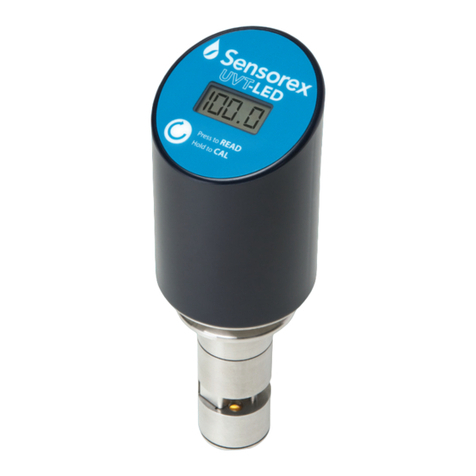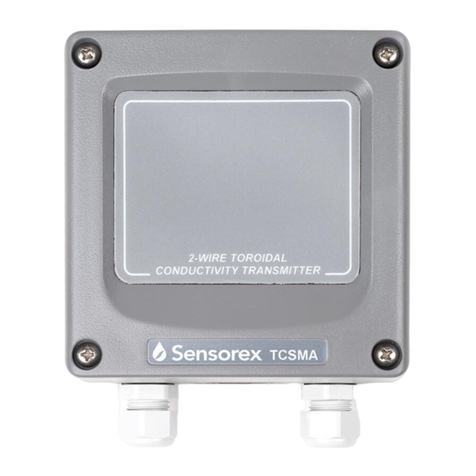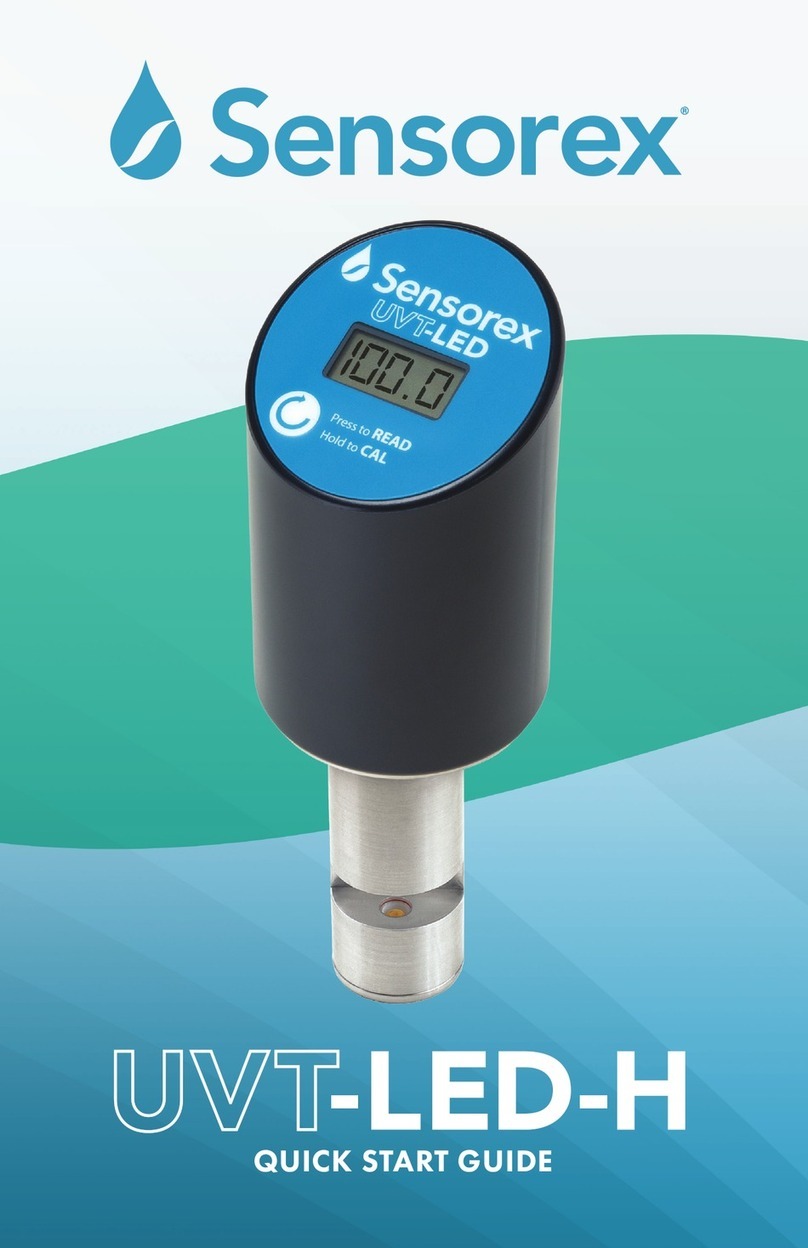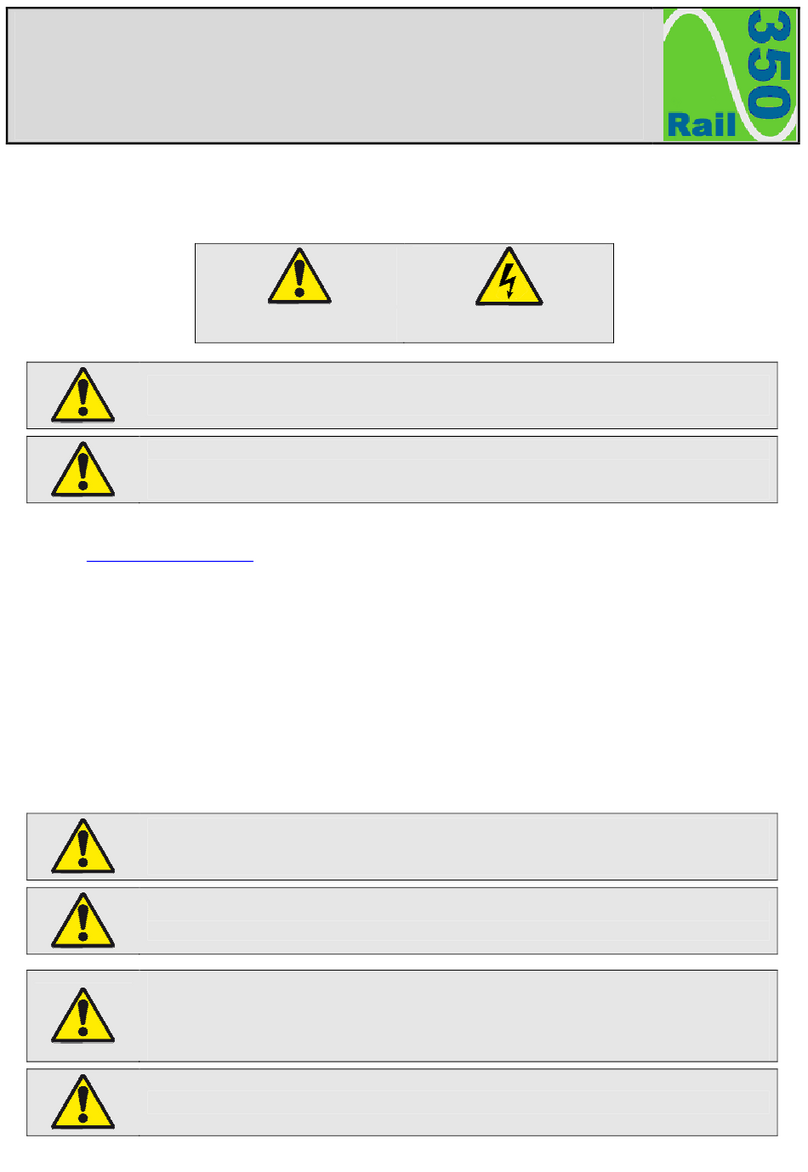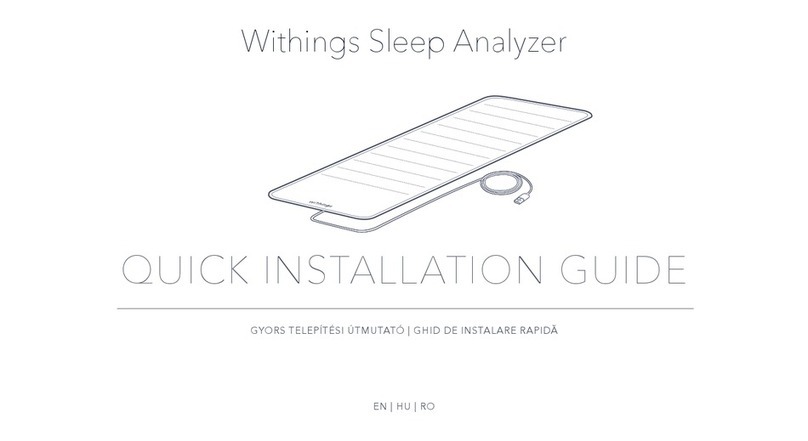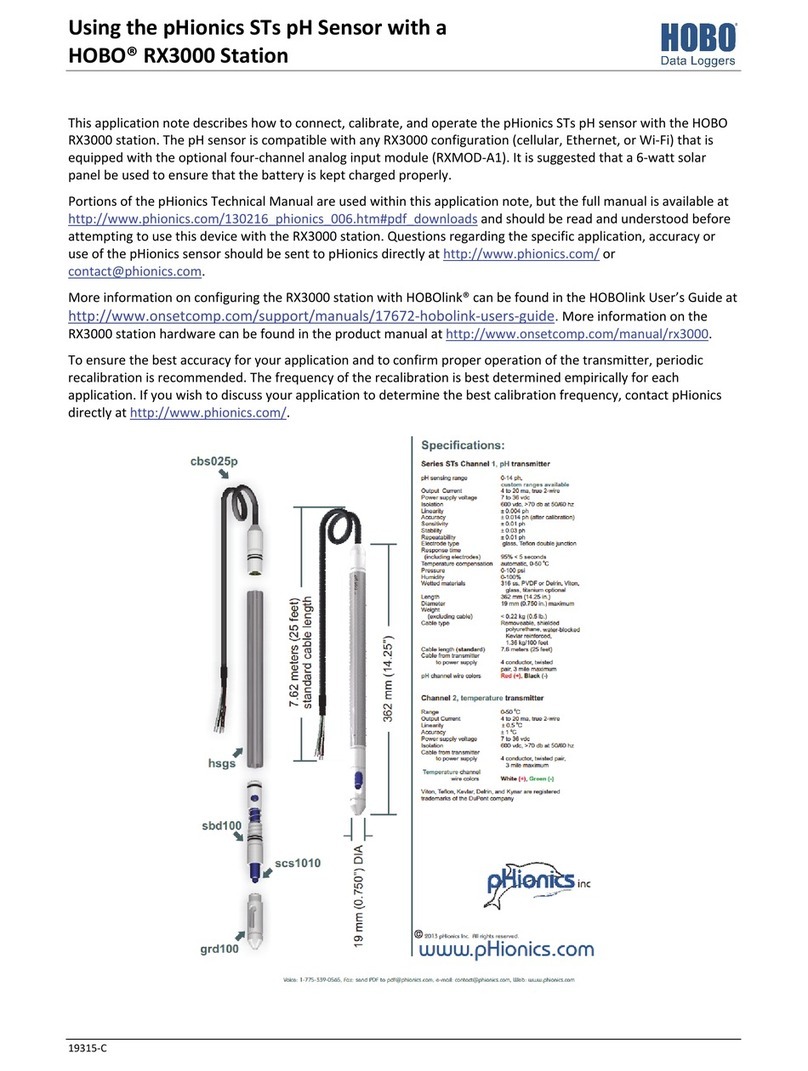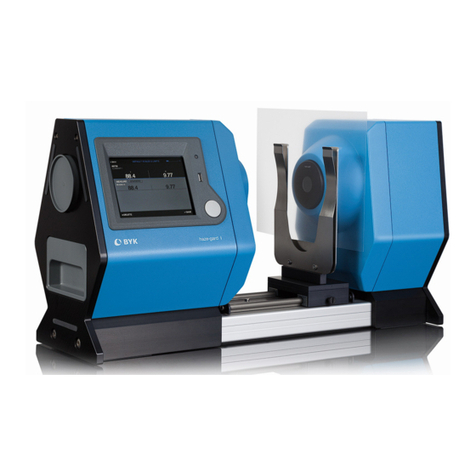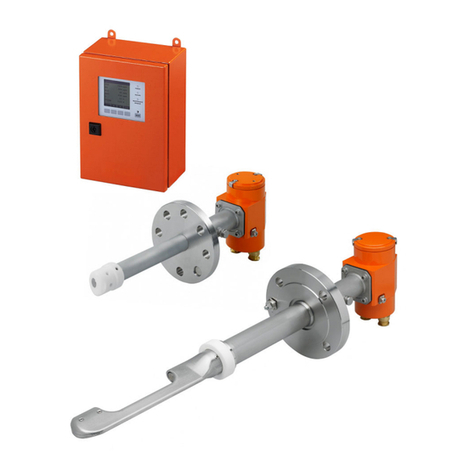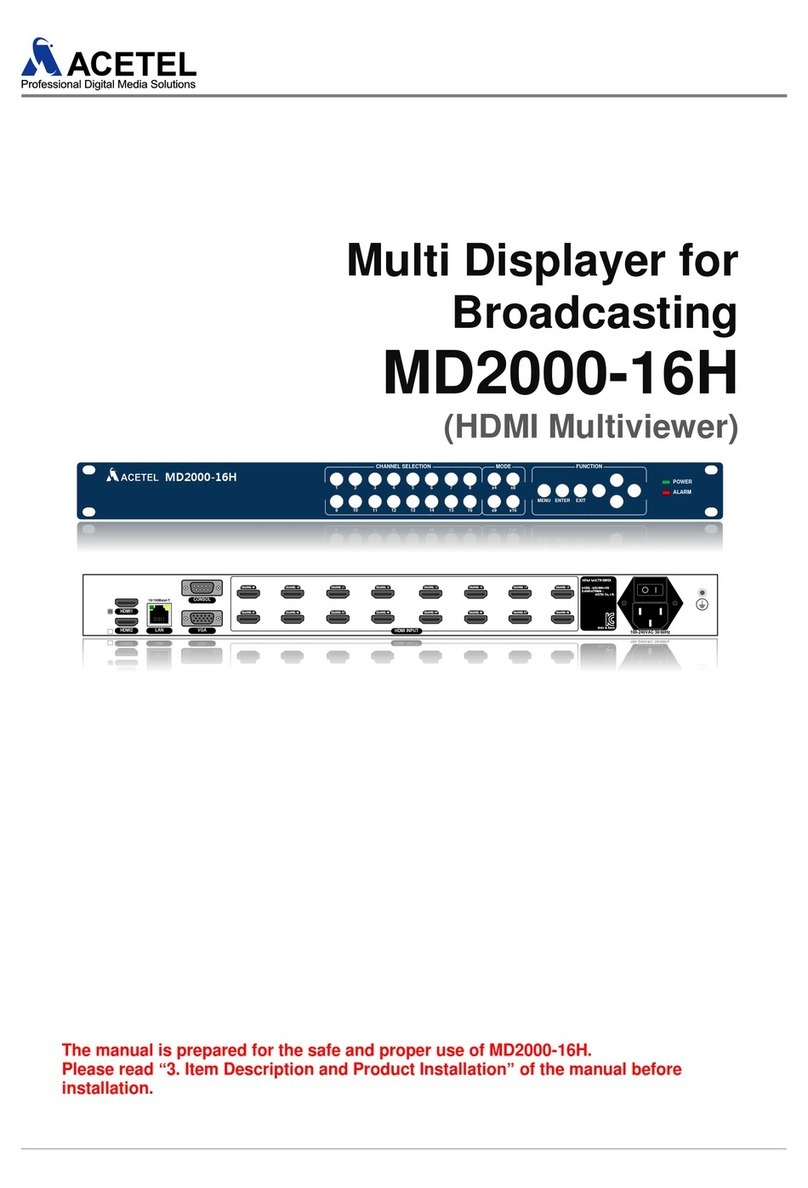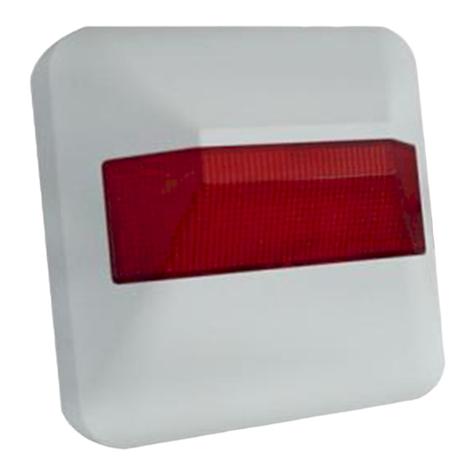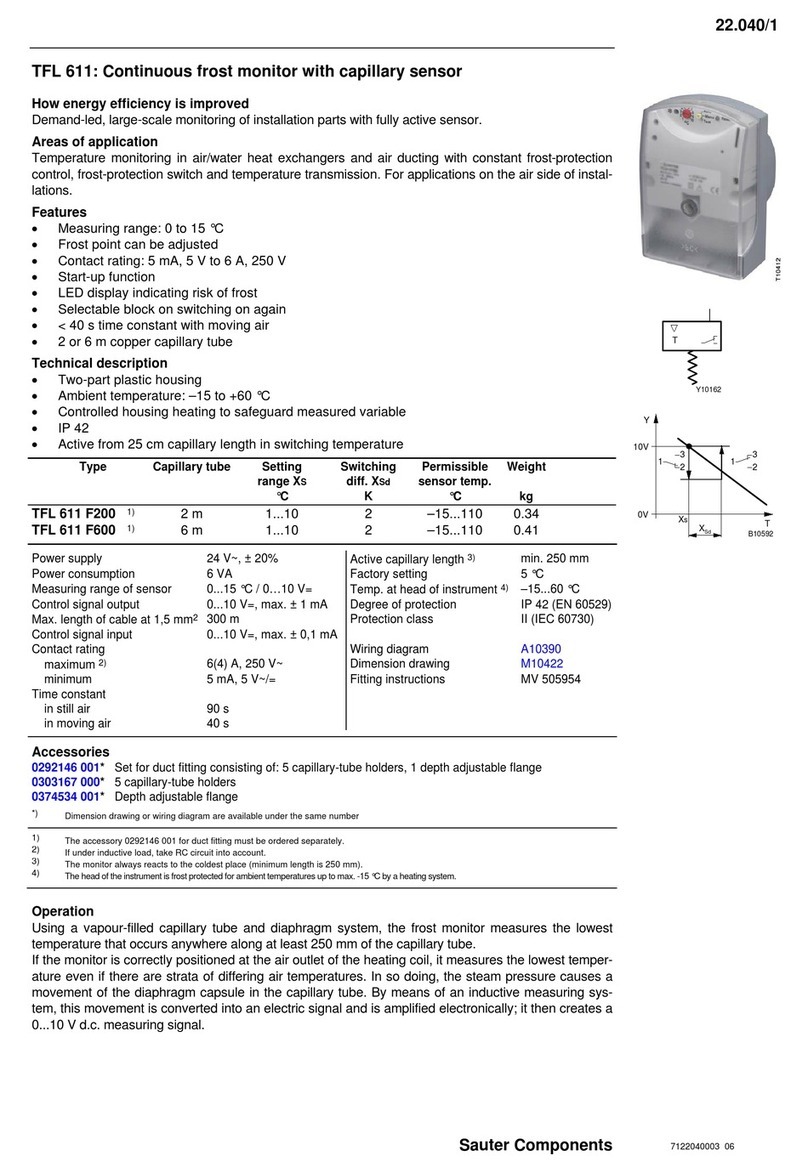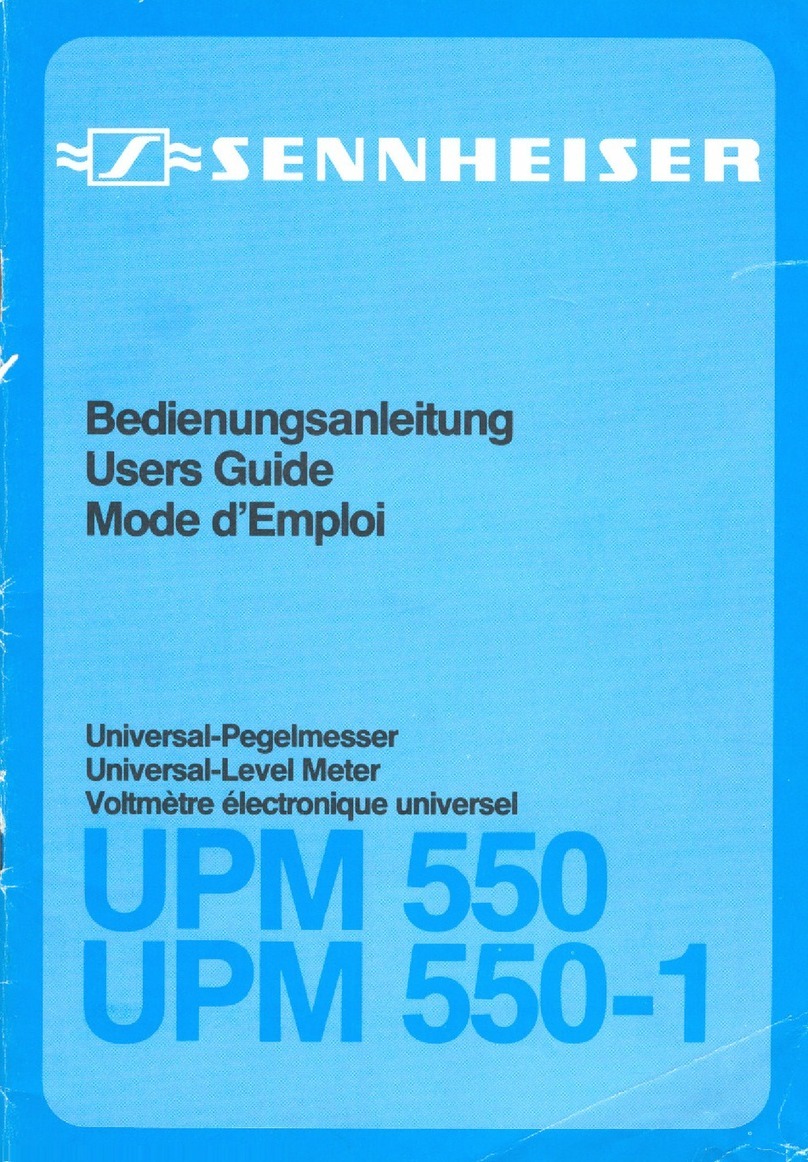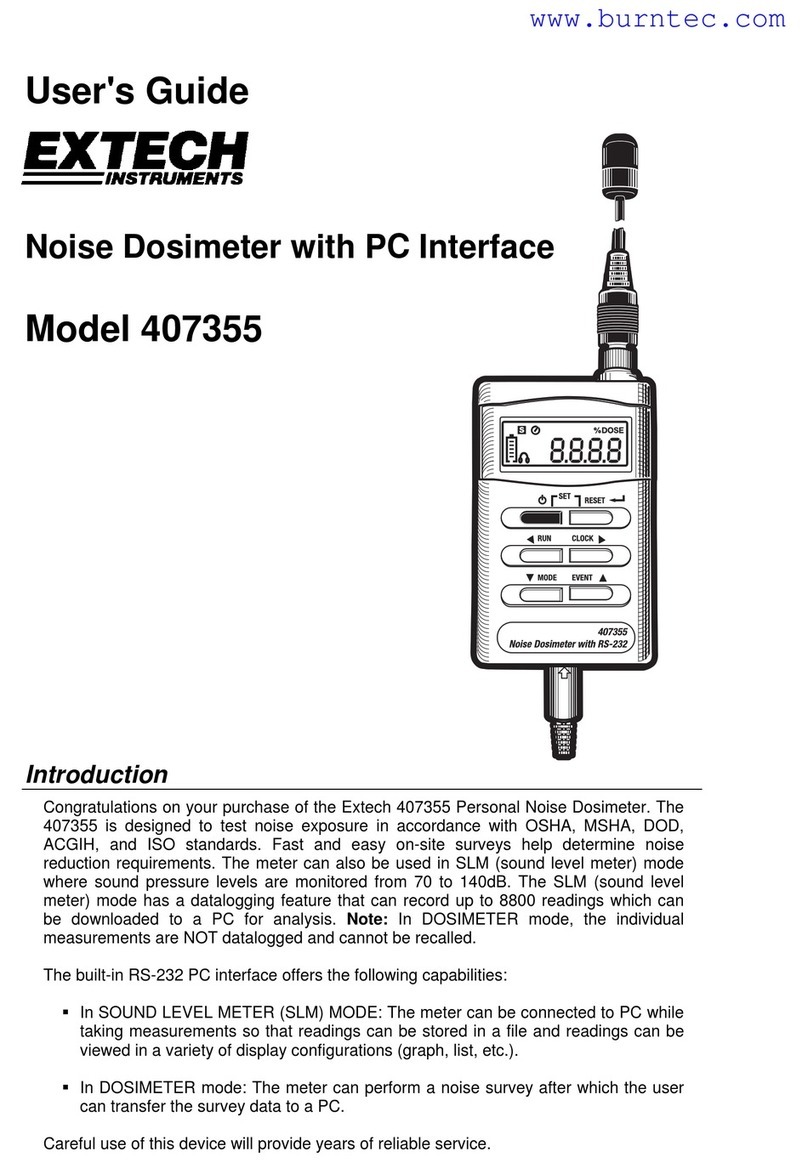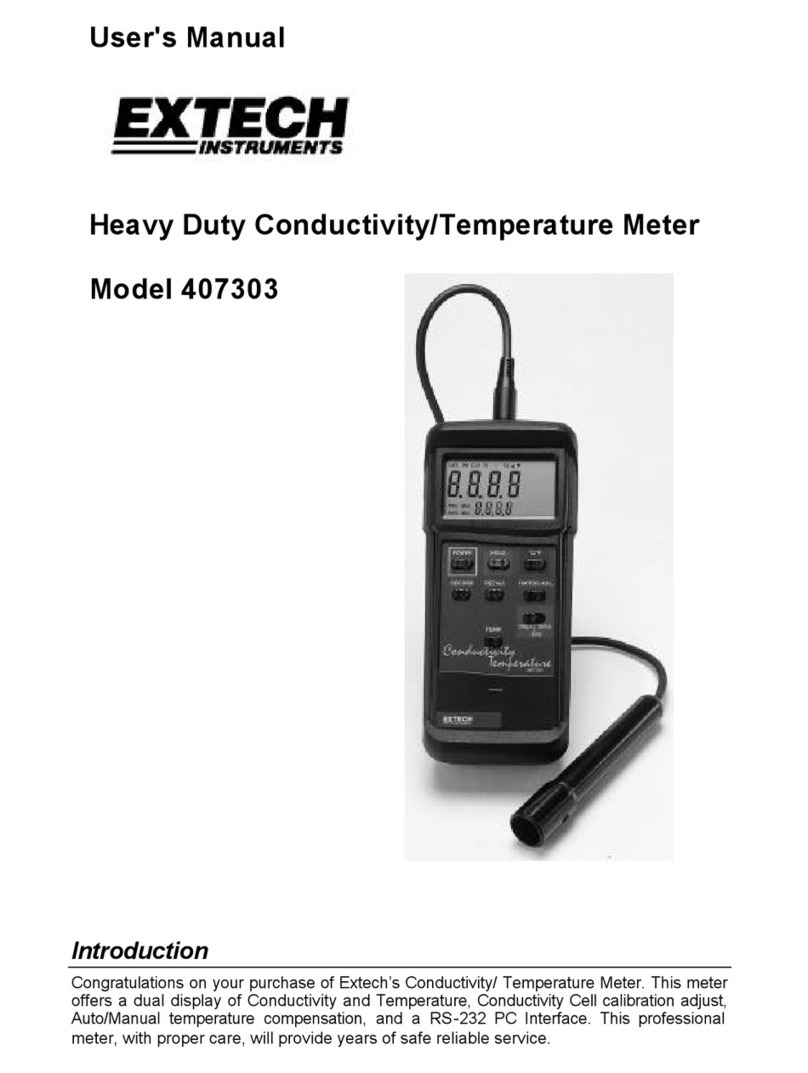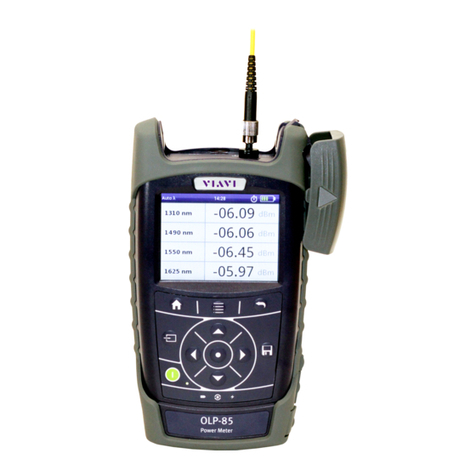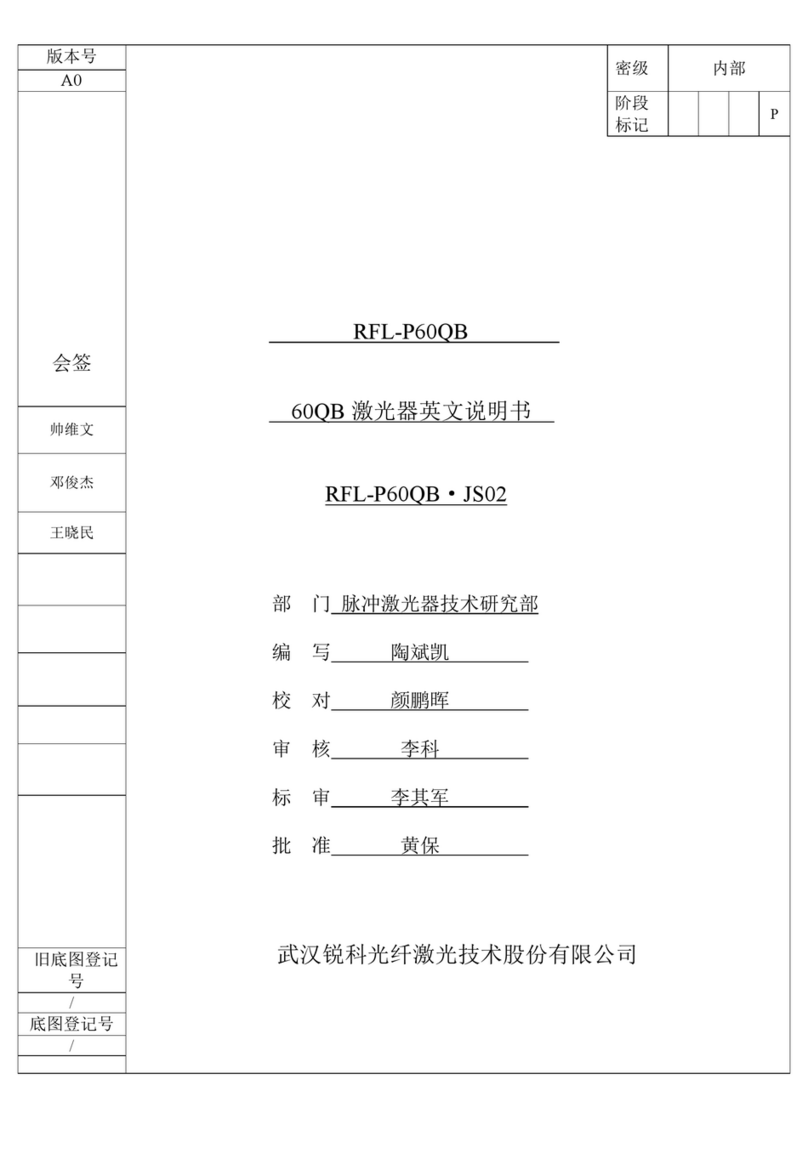Sensorex PM1000 Installation manual

0
Operation Manual
SKU: PM1000
Microcomputer Based
pH/ORP/Temperature
Benchtop Meter
PM1000

1
CONTENTS
GENERAL INTRODUCTION…………………................2
INITIAL INSPECTION……...………………....................2
POWER INPUT…….……...………………......................2
INSTALLING THE BATTERIES..…………....................3
DISPLAY & KEYS FUNCTIONS…..……………..…...…..…3
A. Display ......................................................................3
B. Keys...........................................................................4
OPERATIONAL PROCEDURES..……..........................5
A. Buffer Set Selection.....................................................5
B. pH Calibration.............................................................6
a. Calibration with an ATC/Temp probe in the pH-AUTOLOCK
mode........................................................................6
b. Calibration with manual temperature compensation in the
pH AUTOLOCK mode....................................................7
c. Calibration with an ATC/Temp probe in the pH NON-
AUTOLOCK mode........................................................8
d. Calibration with manual temperature compensation in the
pH NON-AUTOLOCK mode..............................................9
C. pH Measurements........................................................9
a. Measurement with an ATC/Temp probe in the pH-AUTOLOCK
mode........................................................................9
b. Measurement with manual temperature compensation in the
pH AUTOLOCK mode..................................................10
c. Measurement with an ATC/Temp probe in the pH NON-
AUTOLOCK mode......................................................10
d. Measurement with manual temperature compensation in the
pH NON-AUTOLOCK mode............................................11
D. Temperature Measurements.......................................11
E. mV Measurements.....................................................11
a. Measurement in the mV-AUTOLOCK mode....................11
b. Measurement in the mV NON-AUTOLOCK mode.............11
pH BUFFERS..…………………………….....................12
ERROR DISPLAYS AND TROUBLESHOOTING.......13
SPECIFICATIONS………………..……........................14
WARRANTY…………………………….........................15

2
GENERAL INTRODUCTION
Thank you for selecting the PM1000 meter. The PM1000 is a
precision tool that measures pH, mV and temperature. A built-in
microprocessor stores, calculates and compensates for all
parameters related to pH determinations including pH electrode
temperature characteristics, electrode slope deviations and buffer
solutions.
This meter has a waterproof IP54 case. The mechanical keys are
highly reliable with tactile and audio feedback. It is powered by six
AAA-size alkaline batteries or with a UL approved AC adapter
(OUTPUT:DC9V). The meter also displays a “BAT”message when
the batteries are in need of replacement. Re-calibration is not
required when power is restored.
The front of the meter has a large LCD that displays pH or mV and
temperature simultaneously along with user prompts and mode
indicators. The unit prompts the user through calibration and
measurement procedures.
An AUTOLOCK feature for both pH and mV measurements enables
the unit to automatically sense the end point and “LOCK”the display
to indicate the end point value of a measurement. AUTOLOCK and
user prompts help eliminate most errors in determining pH and mV
values, resulting in precise, repeatable and error-free
measurements. The PM1000 can also be used in non-AUTOLOCK
mode.
The model PM1000 is available with pH and ORP probes. Other
features include single or dual or three point calibration, electrode
offset recognition, electrode slope recognition, electrode efficiency
display, built-in buffer coefficients, automatic or manual temperature
compensation, long battery life, and 50/60Hz AC noise rejection.
This meter is user-friendly for laboratory application.
INITIAL INSPECTION
Carefully unpack the unit and accessories. Inspect for damages
made in shipment. If any damage is found, notify your Sensorex
representative immediately. All packing materials should be saved
until satisfactory operation is confirmed.
POWER INPUT
The model 6177 can be powered by an 115V or 230VAC adaptor as
well as 6 “AAA”alkaline batteries. Check the label on the AC

3
adaptor supplied with the instrument to make sure that the AC line
voltage is correct. If the wrong AC adaptor is supplied, notify your
Sensorex representative immediately.
INSTALLING THE BATTERIES
To insert the batteries into the meter, follow the procedure outlined
below.
1. Use a Phillips screw driver and unlock the battery cover by
turning the screw driver in the counter clockwise direction.
After unlocking the screw, take off the battery cover (Fig.1)
2. Replace the old batteries with new ones and install each in
the correct polarity position.
3. Put the battery cover back on the instrument. Use a Phillips
screw driver and turn the screw in the clockwise direction to
lock the battery cover.
Figure 1: Battery compartment
DISPLAY & KEYS FUNCTIONS
A. Display
1
2
3
4
5
6
7
9
10
12
11
8
Figure2: Active LCD screen

4
1. WAIT-
This will be displayed when the
unit is still waiting for a stable
reading or end point sensing.
7. AUTO
AUTOLOCK mode indicator.
2. BAT-
Low battery indicator.
8. Buffer selection
This indicator will flash if the
unit is not yet calibrated. This
indicator will remain light-up if
the unit has been calibrated.
3. pH
Unit and mode indicators.
9. LOCK-
This will indicate that the
reading is frozen during
AUTOLOCK mode.
4. mV
Unit and mode indicators.
10. EFF-
This will be displayed if the
user is viewing the efficiency
of the electrode. It is
recommended to use anew
electrode when the efficiency
value is less than 75%.
5. ATC/MAN-
ATC indicator will be displayed
if a temperature probe is
connected otherwise the MAN
indicator will be displayed.
11. MAIN DISPLAY-
For pH, mV and probe
efficiency values
6. CAL
This will be displayed when the
unit enters into the calibration
mode.
12. SECONDARY DISPLAY-
For temperature in ℃display
B. Keys
Mea.
Eff.
Stand
Slope
Mode
Clear
On/Off-
Press and hold this key for 3 seconds to power on
and shut off the meter.
Mea.
Eff.
Stand
Slope
Mode
Clear
Mode-
Selects display mode. Pressing this key changes the
display sequentially to display pH-AUTO, mV-AUTO,
pH and mV. The calibration values will not be
affected by changing the display modes.
In “pH calibration”, press “Mode”key to exit
calibration mode.

5
Mea.
Eff.
Stand
Slope
Mode
Clear
Clear-
Press to clear the unit when error signal appears.
Clears all calibration values stored in the internal
memory.
During normal use the key will not be activated
unless pressed and held for 2 seconds to prevent
accidentally erasing stored memory.
When the “Clear”key is pressed, all segments of the
LCD will be on. After about 2 seconds the unit will
enter the pH-AUTO mode. The “AUTO”and “CAL”
will be on and one of the buffers in the pre-selected
buffer set will start to flash. This means that the unit
must be calibrated again before use.
Mea.
Eff.
Stand
Slope
Mode
Clear
Mea.
Eff.
Stand
Slope
Mode
Clear
Up/Down-
The two keys are used to manually enter the
temperature values. They have no effect on the unit
when operating in ATC mode.
Mea.
Eff.
Stand
Slope
Mode
Clear
Mea.
Eff.
Stand
Slope
Mode
Clear
Stand/Slope-
The “Stand”and “Slope”keys are used for pH
calibration of the unit. Pressing and holding the
Stand key while turning on the power, will change
the buffer set.
Mea.
Eff.
Stand
Slope
Mode
Clear
Mea. / Eff.-
This key is used to bring the unit out of the AUTO
condition when operating in the pH-AUTOLOCK or
mV-AUTOLOCK mode.
Press and hold this key for 5 seconds, The LCD will
display the efficiency of the electrode.
OPERATIONAL PROCEDURES
A. Buffer Set Selection
The PM1000 meter has two buffer sets: 7.00, 4.01, 10.01pH and
6.86, 4.00, 9.18pH. The meter is factory pre-set at 7.00, 4.01 and
10.01pH.
To change the buffer set, turn off the unit, then press and hold the
“Stand”key while turning on the unit again.
[Note: There is no need to repeat this procedure every time the unit
powers up unless one decides to change the buffer settings.]

6
B. pH Calibration
The PM1000 uses one, two or three point calibration.
[Note: If the unit uses two or three point calibration, the first point
must be 6.86/7.00, and the second point can either be 4.00/4.01 or
9.18/ 10.01.]
a. Calibration with an ATC/Temp probe in the pH-AUTOLOCK
mode.
1. Turn the unit on. Press “Clear”key for 2 seconds, all LCD
elements will light up. The meter clears all calibration values
stored in internal memory.
2. Connect the pH electrode to the BNC connector and the
ATC/Temp probe to the ATC/Temp connector of the unit:
“ATC”icon will light up. “pH”icon and “AUTO”icon will light
up. One of the buffer in the pre-selected buffer set will start to
flash.
3. Rinse the pH and ATC/Temp probes in distilled water then
immerse them in the first buffer solution. Allow temperature
reading to stabilize, then press and hold “Stand”key for 5
seconds to calibrate. The “WAIT”icon will flash until the unit
detects a stable reading. Once the unit calibrates the first
point, the selected buffer remains light up while the remaining
two buffers start to flash. The unit is ready to be sloped at the
second buffer.
[Note:
If the first buffer solution is 7.00 or 6.86, at this moment, press
the “Mode”key. The unit will exit the calibration mode. Single
point calibration is complete.
If the first buffer solution is 4.00, 4.01, 9.18 or 10.00, at this
moment, the unit will automatically exit the calibration mode.
Single point calibration is complete.]
4. Rinse the pH and ATC/Temp probe in distilled water and
immerse them in the second buffer solution (either 4.00/4.01
or 9.18/10.01). Allow temperature reading to stabilize, then
press “Slope”key to calibrate. The “WAIT”icon will flash until
the unit detects a stable reading. Once the unit calibrates the
second point, the selected two buffers light up and the
remaining buffer starts to flash. The unit is ready to be sloped
for the third buffer.
[Note: At this moment, press the “Mode”key. The unit will
exit the calibration mode. Dual point calibration is complete.]

7
5. Rinse the pH or pH/ATC probe in distilled water and
immerse it in the third buffer solution (either 9.18/10.01 or
4.00/4.01). Allow temperature reading to stabilize, then
press “Slope”key to calibrate. The “WAIT”icon will flash
until the unit detects a stable reading. Once the unit
calibrates the third point the unit will automatically exit the
calibration mode. Three point calibration is complete.
6. The unit calculates and compensates for the pH electrode
slope deviation corresponding to the values of the three
calibration buffers. After calibration, press and hold “Mea./
Eff.”key for about 5 seconds to display the new electrode
efficiency.
b. Calibration with manual temperature compensation in the
pH-AUTOLOCK mode.
1. Turn the unit on. Press “Clear”key for 2 seconds, all LCD
elements will light up. The meter clears all calibration values
stored in internal memory.
2. Connect the pH electrode to the BNC connector of the unit,
“MAN”icon will light up. “pH”icon and “AUTO”icon will light up.
One of the buffers in the pre-selected buffer set will start to
flash.
3. Rinse the pH probe in distilled water and immerse it in the first
buffer solution. Adjust the temperature reading to that of the first
buffer using the “up”or “down”keys (0.0 to 60.0℃). Then
press and hold “Stand”key for 5 seconds to calibrate. The
“WAIT”icon will flash until the unit detects a stable reading.
Once the unit calibrates the first point, the selected buffer
remains lit up while the remaining second buffer startsto flash.
The unit is ready to be sloped at the second buffer.
[Note:
If the first buffer solution is 7.00 or 6.86, press the “Mode”
key and the unit will exit the calibration mode. Single point
calibration is complete.
If the first buffer solution is 4.00, 4.01, 9.18 or 10.00, the
unit will automatically exit the calibration mode. Single point
calibration is complete.]
4. Repeat steps 4~6 of “Calibration with an ATC/Temp probe in
the pH-AUTOLOCK mode”for dual and three point calibration.

8
c. Calibration with an ATC/Temp probe in the pH NON-
AUTOLOCK mode.
1. Turn the unit on. Press “Clear”key for 2 seconds, all LCD
elements will light up. The meter clears all calibration values
stored in internal memory.
2. Connect the pH electrode to the BNC connector and the ATC/
Temp probe to the ATC/Temp connector of the unit:
“ATC”icon will light up. Press “Mode”key to select “pH”mode.
“pH”icon is on. One of the buffers in the pre-selected buffer
set will start to flash.
3. Rinse the pH or pH/ATC probe in distilled water and immerse
in the first buffer solution. Allow temperature reading to
stabilize, then press and hold the “Stand”key for 5 seconds
to calibrate, The unit immediately calibrates the first point, The
selected buffer remains lit up while the remaining two buffers
start to flash. The unit is ready to be sloped at the second
buffer.
[Note:
If the first buffer solution is 7.00 or 6.86, at this moment, Press
the “Mode”key, the unit will exit the calibration mode. Single
point calibration is complete.
If the first buffer solution is 4.00, 4.01, 9.18 or 10.00, at this
moment, the unit will automatically exit the calibration mode.
Single point calibration is complete.]
4. Rinse the pH and ATC/Temp probe in distilled water and
immerse them in the second buffer solution (either 4.00/4.01
or 9.18/10.01). Allow temperature reading to stabilize, then
press “Slope”key to calibrate. The unit immediately calibrates
the second point, the other buffer solution will flash. The unit is
ready to be sloped at the third buffer.
[Note: At this moment, press the “Mode”key, the unit will exit
the calibration mode. Dual point calibration is complete.]
5. Rinse the pH and ATC/Temp probe in distilled water and
immerse them in the third buffer solution (either 9.18/10.01 or
4.00/4.01). Allow temperature reading to stabilize, then press
“Slope”key to calibrate. The unit immediately calibrates the
third point and the unit will automatically exit the calibration
mode. Three points calibration is complete.
6. The unit calculates and compensates for the pH electrode
slope deviation corresponding to the values of the three
calibration buffers. After calibration, press and hold “Mea./Eff.”

9
key for about 5 seconds to display the new electrode efficiency.
d. Calibration with manual temperature compensation in the
pH NON-AUTOLOCK mode.
1. Turn the unit on. Press “Clear”key for 2 seconds, all LCD
elements will light up. The meter clears all calibration values
stored in internal memory.
2. Connect the pH electrode to the BNC connector of the unit,
“MAN”icon will light up. Press “Mode”key to select “pH”mode.
“pH”icon is on. One of the buffers in the pre-selected buffer set
will start to flash.
3. Rinse the pH probe in distilled water and immerse it in the first
buffer solution. Adjust the temperature reading to that of the first
buffer using the “up”or “down”keys (0.0 to 60.0℃) before
pressing “Stand”key. Then press and hold “Stand”key for 5
seconds to calibrate. The unit immediately calibrates the first
point, the selected buffer remains light up while the remaining
two buffers start to flash. The unit is ready to be sloped at the
second buffer.
[Note:
If the first buffer solution is 7.00 or 6.86, press the “Mode”key
and the unit will exit the calibration mode. Single point
calibration is complete.
If the first buffer solution is 4.00, 4.01, 9.18 or 10.00, at this
moment, the unit will immediately exit the calibration mode.
Single point calibration is complete.]
4. Repeat steps 4~6 of “Calibration with an ATC/Temp probe in
the pH NON- AUTOLOCK mode”for dual and three point
calibration.
C. pH Measurements
To take pH measurements, the pre-selected buffer solution set must
light up, indicating the unit is Single point or dual-point or three-point
calibrated and ready for measurements. If buffer solution set
flashes, perform a pH calibration before taking measurements.
a. Measurement with an ATC/Temp probe in the pH-
AUTOLOCK mode.
1. Connect the pH electrode to the BNC connector and the
ATC/Temp probe to the ATC/Temp connector of the unit. The
“ATC”icon will light up.

10
2. Press “Mode”key until “pH”icon and “AUTO”icon light up.
3. Rinse the pH electrode and ATC/temp probe with distilled
water and immerse in the sample to be measured. Remove
any air bubbles trapped around the probe by shaking or
stirring the probe.
4. Press the “Mea.”key. The “WAIT”icon will start flashing. The
unit is waiting for a stable reading. The display will track the pH
value as sensed by the pH electrode and the ATC/Temp
probe.
5. When the “WAIT”icon disappears, the reading is then “LOCK”
and will not respond to further changes from the sample. The
pH value shown is the pH value of the sample at the displayed
sample temperature.
[Note: For samples that are inherently unstable, the unit will
not AUTOLOCK. In this case, use the pH NON- AUTOLOCK
mode for measurements.]
b. Measurement with manual temperature compensation in
the pH-AUTOLOCK mode.
1. Connect the pH electrode's BNC connector to the BNC
connector of the unit. The “MAN”icon will light up. Set unit to
display the sample temperature by pressing the up and down
keys(0.0 to 100.0℃).
2. Repeat steps 2~5 of “Measurement with an ATC/Temp
probe in the pH- AUTOLOCK mode”.
c. Measurement with an ATC/Temp probe in the pH NON-
AUTOLOCK mode.
1. Connect the pH electrode to the BNC connector and the ATC/
Temp probe to the ATC/Temp connector of the unit. The
“ATC”icon will light up.
2. Press “Mode”key until “pH”icon lights up.
3. Rinse the pH electrode and ATC/temp probe with distilled
water and immerse in the sample to be measured.
4. Allow sufficient time for the display to stabilize. The instrument
will display the pH value of the sample at the displayed sample
temperature.

11
d. Measurement with manual temperature compensation in
the pH NON-AUTOLOCK mode.
1. Connect the pH electrode to the BNC connector of the unit.
The “MAN”icon will light up. Set unit to display the sample
temperature by pressing the up and down keys(0.0 to 100.0℃).
2. Repeat steps 2~4 of “Measurement with an ATC/Temp
probe in the pH NON- AUTOLOCK mode”.
D.Temperature Measure
The PM1000 can measure temperature independently with the
ATC/temp probe without using the pH electrode. Place the
ATC/temp probe in the sample. The unit will display the measured
temperature.
E. mV Measurements
a. Measurement in the mV-AUTOLOCK mode.
1. Connect the optional combination ORP electrode to the BNC
connector of the unit.
2. Press “Mode”key until “mV”icon and “AUTO”icon light up.
3. Rinse electrode with distilled water and immerse it in sample to
be measured.
4. Press the “Mea.”key. The “WAIT”icon will start flashing. The
unit is waiting for a stable reading. The display will track the
mV value as sensed by the ORP electrode
5. When the “WAIT”icon disappears, the reading is then “LOCK”
and will not respond to further changes from the sample. The
mV value is the sample reading.
[Note: For samples that are inherently unstable, the unit will
not AUTOLOCK. In this case, use the pH NON- AUTOLOCK
mode for measurements.]
b. Measurement in the mV NON-AUTOLOCK mode.
1. Connect the optional combination ORP electrode to the BNC
connector of the unit.
2. Press “Mode”key until “mV”icon lightsup.
3. Rinse electrode with distilled water and immerse it in sample
to

12
be measured.
4. Allow sufficient time for the display to stabilize. The instrument
will display the mV value of the sample.
pH BUFFERS
The temperature coefficient of pH calibration buffers 4.01, 6.86,
7.00,9.18 and 10.01 are stored inside the instrument. The buffers
used to calibrate the instrument must exhibit the same temperature
characteristics as the stored values.
Temperature coefficient of the pH buffers
℃
4.00
6.86
9.18
4.01
7.00
10.01
0
4.01
6.98
9.46
4.01
7.11
10.32
5
4.00
6.95
9.39
4.01
7.08
10.25
10
4.00
6.92
9.33
4.00
7.06
10.18
15
4.00
6.90
9.28
4.00
7.03
10.12
20
4.00
6.88
9.23
4.00
7.01
10.06
25
4.00
6.86
9.18
4.01
7.00
10.01
30
4.01
6.85
9.14
4.01
6.98
9.97
35
4.02
6.84
9.10
4.02
6.98
9.93
40
4.03
6.84
9.07
4.03
6.97
9.89
45
4.04
6.83
9.04
4.04
6.97
9.86
50
4.06
6.83
9.02
4.06
6.97
9.83
55
4.07
6.83
8.99
4.08
6.97
9.80
60
4.09
6.84
8.97
4.10
6.98
9.78
[Note: The actual reading of the instrument can differ from the
values shown by ±0.01pH.]

13
ERROR DISPLAYS AND TROUBLESHOOTING
[Note: If the meter still does not perform normally after the above
measures are taken, contact your Sensorex representative.]
Main
Display
Possible cause(s)
Corrective Action(s)
"Er1"
1. “Stand” was pressed
before the electrode and
ATC/Temp probe settled
to within ±1.5 pH of the
buffer value.
2. pH electrode offset is
greater / less than ±1.5
pH units.
3. pH electrode is faulty.
1. Press “Clear”key, Allow
sufficient time for the
electrode and ATC/Temp
probe to stabilize,then
re-press “Stand”key to
start the calibration
procedure.
2. Replace the buffer and /or
the pH electrode. Press
“Clear” key to recalibrate
meter.
3. Replace electrode.
"Er2"
1. “Slope” was pressed
before the electrode and
ATC/Temp probe settled
to within 30% of the
buffer value.
2. Buffer 4.00, 4.01, 9.18
and 10.01 is not correct.
3. pH electrode slope is off
by more than 30% of
ideal slope.
1. Allowsufficient time for the
electrode and ATC/Temp
probe to stabilize, re-press
“Slope”key to continue the
calibration procedure.
2. Check if the correct buffer
is used.
3. Replace the buffer and /or
the pH electrode. Press
“Clear” key to recalibrate
meter.
"Er3"
1. Temperature is out of
0.0 to 60.0°C range.
1. Bring the buffer
temperature within range.
"over"
/ ”undr”
1. Measured pH is out of
the 0.00 to 14.00 pH
range.
2. Measured mV is out of
–1999.9 to 1999.9 mV
range.
3. Measured temperature is
out of 0.0 to 100.0°C
range.
1. Bring sample pH into the
correct measuring range.
2. Bring sample ORP into the
correct measuring range.
3. Bring sample temperature
into the correct measuring
range.

14
SPECIFICATIONS
Display
Range
Resolution
Accuracy
pH
-2.00 to 16.00 pH
0.01 pH
±0.01 pH
mV
-1999.9 to 1999.9 mV
0.1mV
±0.05%FS
±1digit
Temperature
0.0 to 100.0 °C
0.1 °C
±0.2°C
pH buffer recognition
pH 7.00, 4.01, 10.01 or pH
6.86, 4.00, 9.18
pH Temperature compensation
AUTO/MAN 0.0°C to 100.0 °C
pH Buffer Temperature range
0°C to 60.0°C
pH Electrode Offset recognition
±100 mV at pH 7.00
or +108.3/-91.7mV at pH6.86
pH Electrode Slope recognition
±30% at pH 4.00, 4.01, 9.18
and 10.01
Input impedance
>1012
Ω
Temperature sensor
Thermistor, 10 k
Ω
at 25°C
Power
6X1.5V AAA Batteries or
115/230 AC adatper
Calibration Back-up
EEPROM
Audio Feedback
All Touch Keys
End Point Sensing & Hold
Yes
Display (pH /mV : Temp)
22mm : 14.5mm high LCD
Ambient Temperature Range
0 to 50 °C
Relative Humidity
up to 90%
Case
IP54
Dimensions (W x D x H)
150mm x 210mm x 45mm
Weight
430 grams

15
WARRANTY
Sensorex warrants this product to be free from significant
deviations in material and workmanship for a period of 1 year from
date of purchase. If repair or adjustment is necessary and has not
been the result of abuse or misuse, within the year period, please
return-freight-prepaid and the correction of the defect will be made
free of charge. If you purchased the item from our Sensorex
distributors and it is under warranty, please contact them to notify
us of the situation. Sensorex Service Department alone will
determine if the product problem is due to deviations or customer
misuse.
Out-of-warranty products will be repaired on a charge basis.
RETURN OF ITEMS
Authorization must be obtained from one of our representatives
before returning items for any reason. When applying for
authorization, have the model and serial number handy, including
data regarding the reason for return. For your protection, items
must be carefully packed to prevent damage in shipment and
insured against possible damage or loss. Sensorex will not be
responsible for damage resulting from careless or insufficient
packing.A fee will be charged on all authorized returns.
NOTE: Sensorex reserves the right to make improvements in
design, construction and appearance of our products without
notice.
Sensorex Corp.
11751 Markon Drive
Garden Grove, CA 92841
TEL: 714-895-4344
FAX: 714-894-4839
E-Mail: sales@sensorex.com
Website: www.sensorex.com
Table of contents
Other Sensorex Measuring Instrument manuals
